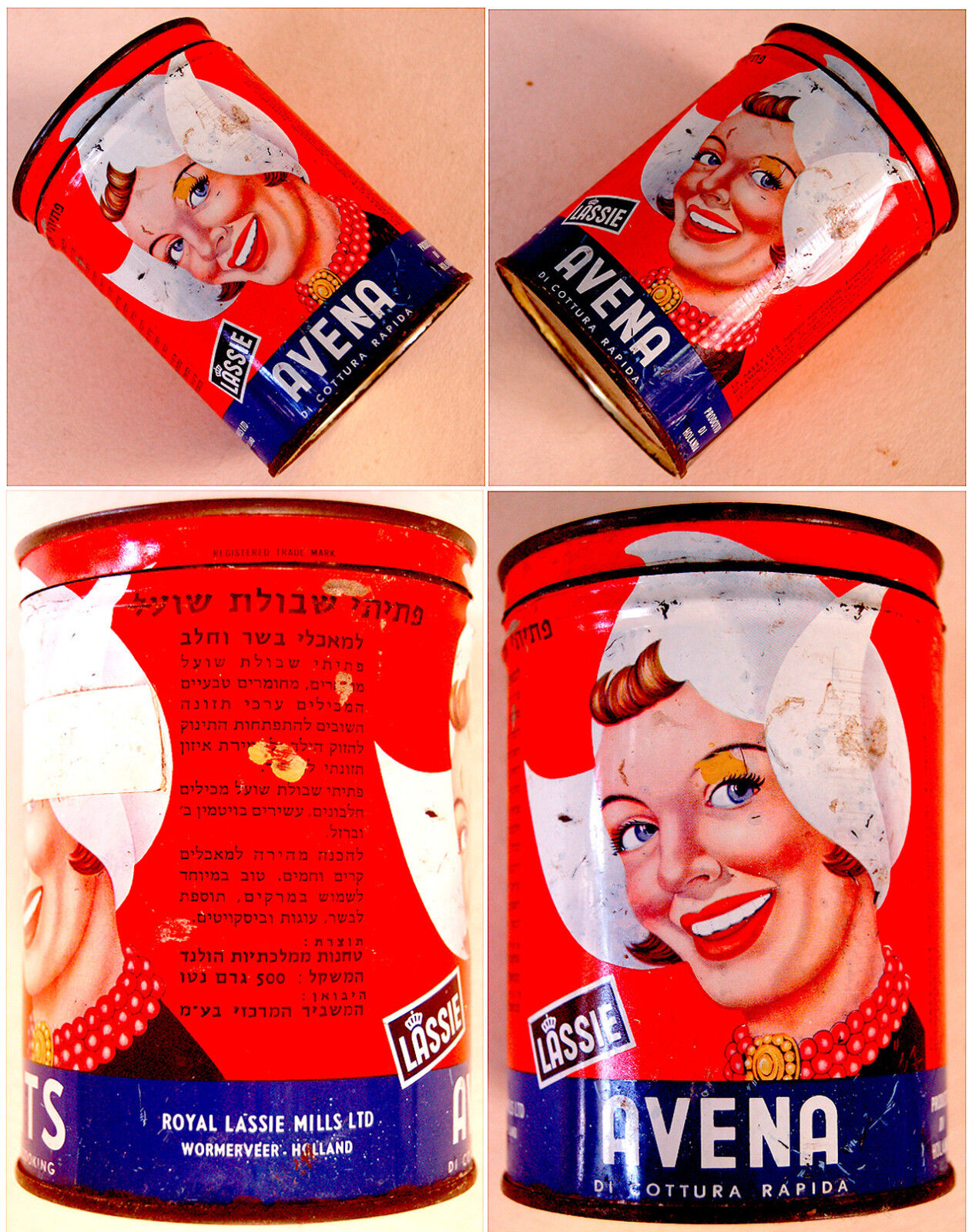1960 Israel LITHO TIN BOX Kosher OATS CAN Judaica AVENA LASSIE Dutch WOMAN

When you click on links to various merchants on this site and make a purchase, this can result in this site earning a commission. Affiliate programs and affiliations include, but are not limited to, the eBay Partner Network.
1960 Israel LITHO TIN BOX Kosher OATS CAN Judaica AVENA LASSIE Dutch WOMAN:
$85.00
DESCRIPOTION : Up for sale is a nicevey rare advertising LITHO TIN BOX - CAN of the original Kosher product , The OATS of \"LASSIE AVENA \" manufactured by Royal Lassie Mills LTD in Holland - Netherlands. Especialy produced for the ISRAEL consumers ca 1950-70 ( Written in Hebrew ). Still containing some of its original content . The ORIGINAL lid is also present. .3.5\"diameterx 5\" High . The LITHO TIN CAN isin a very good conditioninspite its age ( Around 50 years old !! ) , The tin is rigid , Glossy, Vivid colors and in good condition, The TIN CAN is used , but yet in a very nice condition ( Pls look at scan for accurate AS IS images )TINCANwill be sent inside a protectivepackaging .
PAYMENT : Payment method accepted : Paypal.SHIPPMENT : Shipp worldwidevia registered airmail is $14 .Will be shipped inside a highly protective packaging. Handling within 3-5 days after payment. Estimated duration 14 days.The common oat (Avena sativa) is a species of cereal grain grown for its seed, which is known by the same name (usually in the plural, unlike other grains). While oats are suitable for human consumption as oatmeal and rolled oats, one of the most common uses is as livestock feed. OriginThe wild ancestor of Avena sativa and the closely related minor crop, A. byzantina, is the hexaploid wild oat A. sterilis. Genetic evidence shows the ancestral forms of A. sterilis grew in the Fertile Crescent of the Near East. Domesticated oats appear relatively late, and far from the Near East, in Bronze Age Europe. Oats, like rye, are usually considered a secondary crop, i.e., derived from a weed of the primary cereal domesticates wheat and barley. As these cereals spread westwards into cooler, wetter areas, this may have favored the oat weed component, leading to its eventual domestication Oats are grown in temperate regions. They have a lower summer heat requirement and greater tolerance of rain than other cereals, such as wheat, rye or barley, so are particularly important in areas with cool, wet summers, such as Northwest Europe; they are even being grown in Iceland to help prolong the growing season.[3] Oats are an annual plant, and can be planted either in autumn (for late summer harvest) or in the spring (for early autumn harvest).On the Indian subcontinent, oats (known locally in Hindi, Punjabi, Awadhi, Bhojpuri, and Nepali languages as \"jaei\" (जौ)) are grown on the foothills of Himalayas, such as in the Indian state of Punjab, Uttar Pradesh and Bihar. References to its cultivation can be found in the epic Mahabharat.Oats have numerous uses in foods; most commonly, they are rolled or crushed into oatmeal, or ground into fine oat flour. Oatmeal is chiefly eaten as porridge, but may also be used in a variety of baked goods, such as oatcakes, oatmeal cookies, and oat bread. Oats are also an ingredient in many cold cereals, in particular muesli and granola.Historical attitudes towards oats have varied. Oat bread was first manufactured in Britain, where the first oat bread factory was established in 1899. In Scotland, they were, and still are, held in high esteem, as a mainstay of the national diet.In Scotland, a dish called cow pat was made by soaking the husks from oats for a week, so the fine, floury part of the meal remained as sediment to be strained off, boiled and eaten.[4] Oats are also widely used there as a thickener in soups, as barley or rice might be used in other countries.Oats are also commonly used as feed for horses when extra carbohydrates, and the subsequent boost in energy, are required. The oat hull may be crushed (\"rolled\" or \"crimped\") for the horse to more easily digest the grain,[citation needed] or may be fed whole. They may be given alone or as part of a blended food pellet. Cattle are also fed oats, either whole, or ground into a coarse flour using a roller mill, burr mill, or hammer mill.Winter oats may be grown as an off-season groundcover and ploughed under in the spring as a green fertilizer, or harvested in early summer. They also can be used for pasture; they can be grazed a while, then allowed to head out for grain production, or grazed continuously until other pastures are ready.[5]Oat straw is prized by cattle and horse producers as bedding, due to its soft, relatively dust-free, and absorbent nature. The straw can also be used for making corn dollies. Tied in a muslin bag, oat straw was used to soften bath water.Oats are also occasionally used in several different drinks. In Britain, they are sometimes used for brewing beer. Oatmeal stout is one variety brewed using a percentage of oats for the wort. The more rarely used oat malt is produced by the Thomas Fawcett & Sons Maltings, and was used in the Maclay Oat Malt Stout before Maclays Brewery ceased independent brewing operations. A cold, sweet drink called avena made of ground oats and milk is a popular refreshment throughout Latin America. Oatmeal caudle, made of ale and oatmeal with spices, was a traditional British drink and a favourite of Oliver Cromwell.[6][7]Oat extract can also be used to soothe skin conditions.Oat grass has been used traditionally for medicinal purposes, including to help balance the menstrual cycle, treat dysmenorrhoea, and for osteoporosis and urinary tract infections.[8]
1960 Israel LITHO TIN BOX Kosher OATS CAN Judaica AVENA LASSIE Dutch WOMAN:
$85.00
